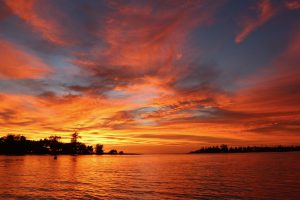Most people, if asked to describe South Pacific cuisine, would probably imagine fresh fish and tropical fruits. The potential enjoyment of such victuals was certainly high on our list of reasons to go on our big trip in the first place. Happily, this culinary vision is fairly accurate; both items are among the most abundant resources of the region, although a distant second compared to seawater. This is the epic tale of how some of those highlights became too much of a good thing in the end.
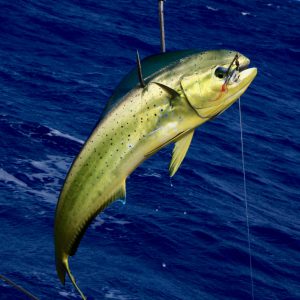
Our initial fishing efforts were auspiciously productive. On the first leg of the journey, from California to the Big Island, we caught one Yellowfin Tuna, two Mahi Mahi and a smaller fish that we only rated a single Mahi. These were followed by a Skipjack Tuna later on that was so fiesty he busted one of our aging reels. Our crew rendered various aid in consuming the aforementioned pelagic acquisitions. But after that, we set off on our own. From that point forward, a tug on the line meant over a week of fish at every possible meal. With the exception of one Wahoo at the end, all the other fish we caught under way in the South Pacific were Yellowfin Tuna. While the cat was highly enthusiastic about this new treat, a fridge full of big fillets was rather daunting to us.
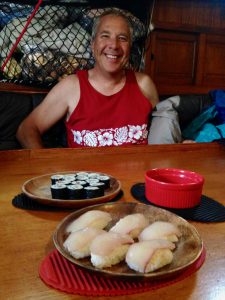
Zara’s tastes were simple: she devoured lightly boiled trimmings with much gusto as long as they were relatively fresh. Our palates, on the other hand, required additional variety. To that end, we developed a timeline of favorite preparations that became our standard for each new catch. The order of recipes went thusly: sushi and related forms of raw fish were the obvious first steps. The occasional seared tuna steak also began to trend during these early stages. Next was ceviche. Fish tacos usually made a showing around this point. Then the steaks and the ceviche batch peaked and quickly waned together. The final phase was always tuna salad, either on sandwiches or as pasta salad. Other creations were inserted to keep things interesting, but the aforementioned regime was our go-to for many months.
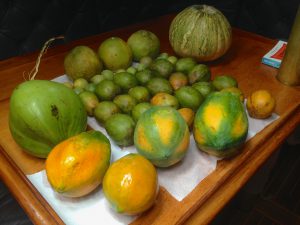
But what about the bananas, you may be asking? Fear not, gentle reader; they are far from forgotten. Their first appearance in this story was in unremarkable quantities, when we landed in the Marquesas and took advantage of new access to produce vendors. But when we left the island group, we stocked up on produce via trade with a nearby local. He requested 30 feet of rope, some AAA batteries, and a half a liter of Jack Daniel’s Whiskey, among other sundry items. In exchange we received a generous supply: a pile of limes; several coconuts, papayas, and pamplemousse; a large hard squash; 30+ weird fruits that we had never seen before; and our first entire stalk of bananas. It was hard enough to stow one bunch so that it wouldn’t bruise while on the rocking, roller coaster ride of a sailboat, much less a whole stalk.No sailing lessons had specifically prepared us for that moment, but we applied a collection of bungees and paracord with some reputable knots to suspend it over the cockpit seat like some large, tropical mistletoe. Thus adorned, we set sail for the Tuamotus.
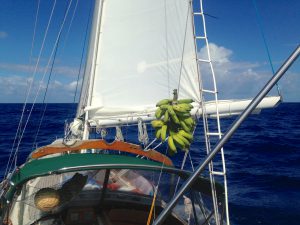
The five day, downwind passage was the most perfect sailing we saw the whole trip. The wind was moderate and steady, the Perseids were near peak, and of the few clouds we saw, the most notable was the green, ripening one swaying gently over the wheel. There was little to do in regards to the 74 yellowing fruits for the first two days. On the third night we started to change watch as usual at 2am, with almost nothing to report. *Thud* Our senses perked up at the soft sound, and we set to searching the cockpit for the source. *Thud* One fallen banana at our feet quickly became two, and then three, as our sleepy brains began to wrap around the concept of their arrival. In a flash, we were rushing about with activity, as the bananas rained down on our heads! Amid the deluge, we struggled in the dark to disassemble the ad-hoc rigging while gently holding the heavy, swinging stormcloud. Our team effort prevailed, and before long the cut bunches were secured below, cheerfully decorating several storage hammocks.
And so began the era of banana rations. Previous smaller stocks necessitated a two banana/day maximum for each person. The new hoard required a six banana/day minimum per person. Naturally, that rate was unsustainable in the long term, and after a few days we resorted to several cooking methods to dispatch the reminder. Once gone, we enjoyed a good long break from all things banana over the next month. Zara needed no such break, as she disdained any part in the fruit consumption from the very beginning.
The cycles started all over again when our friend Nick joined us on Tahiti. As we were duly rested from the previous banana engorgement, we bought a new but smaller stalk at the market before our departure. Nick was true to his word of providing support in the new banana battle. No rationing minimums or maximums were imposed, but frequent consumption was highly encouraged. Like all bunches of banana since the beginning of time, there was always a day when every single one seemed to ripen at once. One afternoon I picked out a set of tiny ones, no bigger than two or three bites each, and proceeded to eat nine of them in one sitting. Though I didn’t suffer too much because of it, I wouldn’t do it again. Kids, don’t try this at home.
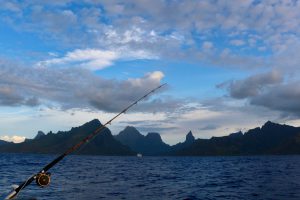
Anyone missing the fish yet? We had started to, so as we departed an anchorage one evening, we set up the lines in the fading light of the beautiful day. Before long, the reel sang out its cry, warning us of the line pulling away fast. Its serenade was the prelude to an hour long fight to bring in what seemed like a fish the size of an island. The three of us barely managed to boat the beast, which was nearly twice the size of our usual tuna. Though we lacked a scale, it could have easily weighed over 50 pounds.
The following two weeks were the most tuna-intense of the entire trip. We pulled out all the stops during meals to keep the repetitive ingredient interesting. Thankfully, Nick liked fish, and proved a most invaluable asset in conquering the huge amount of meat. Even with the added reinforcements, we had more than enough and were all quite tired of it in the end. We were also still on break from bananas when Nick departed for the real world.
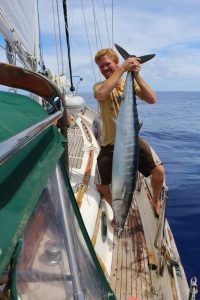
The only other fishing event of note was the wahoo, the last fish of the trip. It was probably as big as the monster tuna, but fortunately it was well timed too. We caught it just offshore of Palmerston Island, where each boat is adopted by a host family. Only half of the fillets were processed and secured down below before we had to pick up our mooring. As we secured our lines, the family gladly received the other half of the fish, which started the week off on a good note. We ate some of it with them during joint meals ashore, and plenty back on Serenity. Although it was a nice change from the tuna, we were also somewhat happy to see it gone.
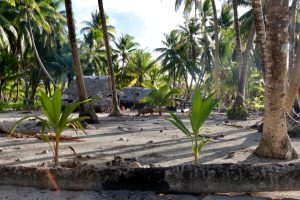
While that was the last we saw of fish, the banana zenith was yet to come. Our last stop was Tabuaeran, known as Fanning Island, which lies about 900 nautical miles south of Honolulu. Their supply ship had been significantly delayed, and we were happy to share some of our stores with the people we befriended. They still wanted to repay us in some way, so we accepted piles and piles of coconuts, along with the offer of a stalk of bananas. The first stalk they procured was huge; even half would have been far more than we could possibly use. I struggled to assure them of our appreciation while at the same time requesting a more manageable quantity. An expedition was mounted to repair the situation, while I continued visiting with people. Then word came that the second, allegedly smaller stalk had been directly placed, sight unseen, in our dinghy. I was filled with apprehension as I approached for a look – perhaps it would be nearly the same size as the previous behemoth. Instead I sighed with relief; it was absolutely perfect.
Back on the boat, we happily suspended the gift in the usual location, where they could see from shore that it been well received. Two days later, we were bustling about, making our final preparations to leave later that morning. Suddenly, we spotted a kayak pulling up near us, paddled by a complete stranger. Puzzled, we greeted him, whereupon he gave us another stalk of bananas, the same size at the one hanging prominently over the cockpit. We thanked him as best we could, but it was hard to appreciate the white elephant. Somehow we managed to rig it in a second, nearby location that wouldn’t crash into the first stalk or our heads, and got underway.
It was a good thing that we hadn’t seen much fresh fruit in a while, because otherwise the impossible task would have been even more foreboding. I couldn’t bring myself to count them; it would only have made things worse. Still determined to do our best, we got to work as soon as the first ones ripened. This time, no mere six banana minimum would do; our daily allotment was TWELVE bananas each. We ate them in threes and fours, lasting only a few days at those rates before our efforts flagged. A few half-hearted cooking creations also went mostly untouched, especially as we approached Oahu. When the agricultural inspector came to remove any remaining foreign produce, we were rather grateful to send away the last browning bananas.
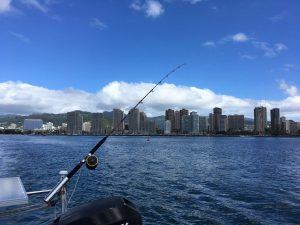
We’ve often remarked on how similar the Hawaiian islands are to many of those in the South Pacific. Their resources are one of the best commonalities; landing in Honolulu meant seeing a lot of our favorite foods from the trip. But, unsurprisingly, it was quite a while before we wanted any fish or bananas at all.

